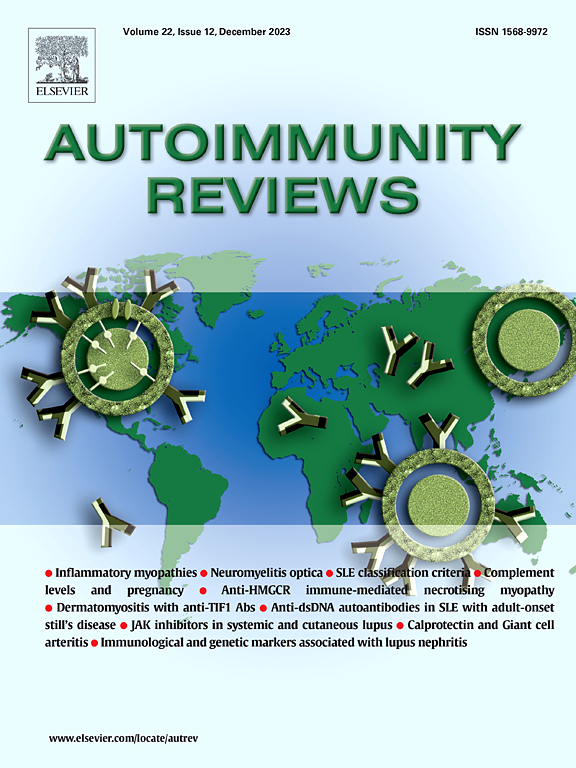Proportion of circulating T follicular helper cells in peripheral blood of systemic lupus erythematosus patients: A systematic review and meta-analysis
IF 8.3
1区 医学
Q1 IMMUNOLOGY
引用次数: 0
Abstract
Objectives
Dysregulation of circulating follicular helper T (cTfh) cells plays a key role in the breakdown of immune tolerance and the pathogenesis of antibody-mediated autoimmune diseases, including systemic lupus erythematosus (SLE). This study aims to evaluate the proportions of cTfh cells and their potential pathogenic mechanisms in the peripheral blood of SLE patients through a systematic review and meta-analysis.
Methods
Systematic search and review were conducted across PubMed, Cochrane Library, EMBASE, and Web of Science to identify relevant studies. A meta-analysis was performed to compare the proportions of cTfh cells and their subsets between SLE patients and healthy controls (HC). Subgroup analyses were conducted based on the markers used for defining cTfh cells and geographical regions.
Results
The meta-analysis revealed a significantly higher proportion of cTfh cells in SLE patients compared to HC (SMD 0.904, [0.620, 1.188], p < 0.01). Subgroup analyses showed a consistent increase in cTfh cells in SLE across different markers. Geographically, both Asian (SMD 1.005, [0.608, 1.402], p < 0.01) and non-Asian populations (SMD 0.708, [0.428, 0.988], p < 0.01) demonstrated elevated cTfh cell proportions in SLE. A trend toward a decrease in Tfh1 cells and an increase in Tfh17 cells was observed, though neither reached statistical significance.
Conclusion
Our study demonstrates that cTfh cells proportions are significantly elevated in SLE patients, supporting their role in the pathogenesis of SLE. These findings suggest that cTfh cells could serve as potential biomarkers for SLE and therapeutic targets for treatment.

系统性红斑狼疮患者外周血中循环T滤泡辅助细胞的比例:系统回顾和荟萃分析
目的:循环滤泡辅助性T细胞(cTfh)的失调在免疫耐受的破坏和抗体介导的自身免疫性疾病(包括系统性红斑狼疮(SLE))的发病机制中起着关键作用。本研究旨在通过系统综述和荟萃分析,评估cTfh细胞在SLE患者外周血中的比例及其潜在致病机制。方法通过PubMed、Cochrane Library、EMBASE和Web of Science进行系统检索和综述,确定相关研究。进行了一项荟萃分析,比较SLE患者和健康对照(HC)之间cTfh细胞及其亚群的比例。根据用于定义cTfh细胞和地理区域的标记物进行亚组分析。结果荟萃分析显示,SLE患者中cTfh细胞的比例明显高于HC (SMD = 0.904, [0.620, 1.188], p <;0.01)。亚组分析显示,不同标记的SLE患者cTfh细胞一致增加。地理上,亚洲(SMD 1.005, [0.608, 1.402], p <;0.01)和非亚洲人群(SMD = 0.708, [0.428, 0.988], p <;0.01)表明cTfh细胞比例在SLE中升高。Tfh1细胞呈减少趋势,Tfh17细胞呈增加趋势,但均未达到统计学意义。结论cTfh细胞比例在SLE患者中显著升高,支持其在SLE发病机制中的作用。这些发现表明cTfh细胞可以作为SLE的潜在生物标志物和治疗靶点。
本文章由计算机程序翻译,如有差异,请以英文原文为准。
求助全文
约1分钟内获得全文
求助全文
来源期刊

Autoimmunity reviews
医学-免疫学
CiteScore
24.70
自引率
4.40%
发文量
164
审稿时长
21 days
期刊介绍:
Autoimmunity Reviews is a publication that features up-to-date, structured reviews on various topics in the field of autoimmunity. These reviews are written by renowned experts and include demonstrative illustrations and tables. Each article will have a clear "take-home" message for readers.
The selection of articles is primarily done by the Editors-in-Chief, based on recommendations from the international Editorial Board. The topics covered in the articles span all areas of autoimmunology, aiming to bridge the gap between basic and clinical sciences.
In terms of content, the contributions in basic sciences delve into the pathophysiology and mechanisms of autoimmune disorders, as well as genomics and proteomics. On the other hand, clinical contributions focus on diseases related to autoimmunity, novel therapies, and clinical associations.
Autoimmunity Reviews is internationally recognized, and its articles are indexed and abstracted in prestigious databases such as PubMed/Medline, Science Citation Index Expanded, Biosciences Information Services, and Chemical Abstracts.
 求助内容:
求助内容: 应助结果提醒方式:
应助结果提醒方式:


